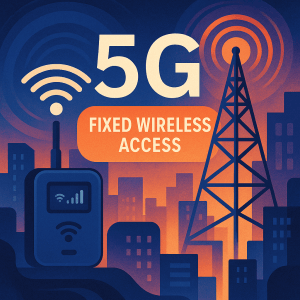AI-powered search has reached a critical turning point, fundamentally changing how B2B buyers find, assess, and shortlist vendors. The latest New Rules of Visibility study, produced by Kickstand, a tech PR firm specializing in AI, and Pavilion, the world’s largest private community of GTM leaders, featuring insights from over 600 GTM leaders, offers one of the clearest views yet of how AI engines are changing the rules of brand visibility.
For most of the digital age, the goal was simple: rank on page one. Today, that model is changing. AI assistants like ChatGPT, Claude, Gemini, Grok, and Perplexity have become the first stop for buyer research. They compile answers, assess authority, and recommend vendors directly, skipping search results entirely.
The shift is clear: 38% have already reported a drop in web traffic, even among brands with strong brand equity. This supports theCUBE Research’s own study, which indicated that B2B companies should expect a 33-40% decline in traffic over the next four years. In addition, a majority said that traditional SEO (search engine optimization) has only been “slightly effective.”
Leaders are noticing. According to the study, 6 in 10 reported that senior leadership has already asked about their brand’s visibility in AI-generated answers. Most often, it’s the CEO (24%), CMO (23%), or even the board (18%).

This is not a future-state scenario. It is the buyer journey now. An AI-powered search and buyer journeys.
Traditional SEO signals like keywords, backlinks, and click-through rates are gradually being replaced by more significant metrics:
- Independent validation
- Entity clarity
- Storytelling depth
- Authoritative leadership
- Third-party credibility
- Visibility on trusted platforms.
The survey’s findings show that the competition has shifted from rankings to recognition, citations, and inclusion in algorithmically generated answers (also known as AI assistants).
AI is the New Buyer Gateway
The survey indicates a sharp shift away from traditional search toward AI-powered search. Nearly 46% of GTM leaders believe LLMs will replace conventional search within the next few years, highlighting a fundamental change in how buyers initially understand vendors.
They are right, in our view.
As theCUBE Research has pointed out, as illustrated below, the time to act is now.
By 2026, most buyers will prefer AI assistants over search engines for early research and vendor comparisons. By 2030, it’s expected to account for 70–80% of B2B software research, resulting in a 42-point visibility gap versus SEO.
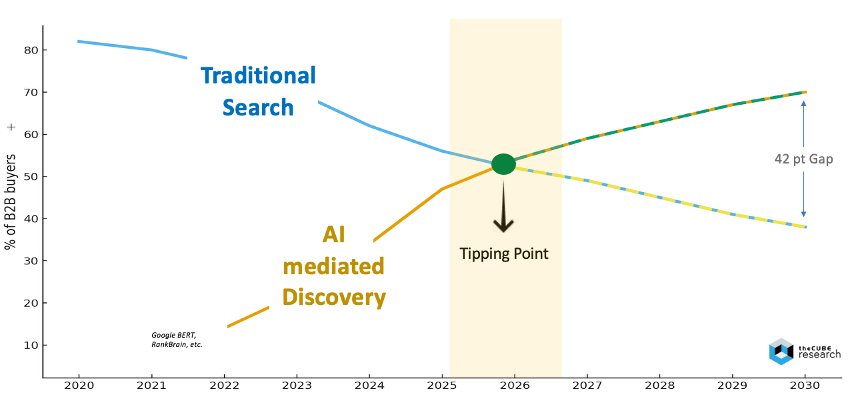
This decline is caused by zero-click behavior as AI systems generate and provide answers directly, bypassing websites entirely. Traditional SEO strategies are losing visibility and control to AI engines that determine which brands to feature in their synthesized responses.
The Bottom Line: If your brand isn’t visible to AI, it may become invisible to your buyers.
This is because buyers now ask natural-language questions that directly reflect their intent, such as “What’s the best workflow platform for mid-size financial services firms?” or “Which vendors offer AI-powered compliance for healthcare?” and AI systems respond by synthesizing insights from their knowledge maps, trusted media, expert interviews, transcribed events, and credible research.
This is a profound change. Visibility is now determined by a model’s ability to:
- Understand your brand as an entity.
- Match your content to the buyer’s intent.
- Trust the provenance and credibility of your insights.
- See your brand reinforced across independent, high-authority sources.
Brands that surface consistently are those that design content and distribution for this new architecture. Brands that don’t are being filtered out before the buyer journey even begins.
These shifts highlight the need for a deeper understanding of how LLMs learn about brands, evaluate authority, and decide which organizations to surface in answers. Our cornerstone guide to AI Engine Optimization (AEO) explains the four-layer, 19-attribute framework used to improve visibility and answer inclusion across AI engines.
Most Brands Are Not Ready
Despite the rapid pace of this shift, the Kickstand + Pavilion survey uncovers a significant readiness gap: 77% of GTM leaders admit they lack a clear AI engine discovery strategy, and only a few feel confident in their ability to improve visibility in AI-powered search answers.
This lack of readiness begins with outdated assumptions.
- Many still rely on outdated SEO tactics.
- Many assume website content alone can shape early discovery.
- Many underestimate how heavily AI engines weigh third-party credibility.
- Many believe volume matters more than authority and structure.
- Many don’t produce a steady stream of conversational content.
Molly George, CEO of Kickstand, summarized it well:
“AI search is evolving faster than the teams trying to harness it.”
The good news is that more and more GTM leaders are acting, yet they’re far from confident that their current playbook will hold. The AI visibility shift is happening faster than most organizations can keep up with best practices, creating a fragmented landscape of trial-and-error efforts.

One of the key findings from the study is the apparent lack of expertise across the market. Only 6% of GTM leaders surveyed see themselves as true “experts,” and just 29% feel “very knowledgeable,” leaving the vast majority navigating this change with little or no understanding of how AI engine optimization works. That is, how to increase the odds of their brand being recognized and surfaced in AI answers.
The implications become even clearer when paired with the most common challenges:
- 45% of GTM leaders don’t have a defined AI visibility strategy
- 34% don’t know how to ensure their brand shows up in AI answers
- 34% don’t understand which factors actually influence AI-generated results.
This is not a skills gap at the margins; it is a strategic blind spot at the center of modern go-to-market. Without foundational knowledge of how AI-powered search works, marketing and communications teams cannot design credible visibility programs, build CAAT-aligned content, or measure performance in a zero-click world.
For many organizations, the obstacle isn’t technology—it’s capability. As AI-driven discovery rapidly changes how buyers develop their consideration sets, this lack of expertise risks increasing the competitive gap.

The brands that act now, by building internal literacy, adopting structured AEO (AI Engine Optimization) methodologies, and implementing best practices, will gain significant visibility. Those that don’t face the risk of disappearing from the answers buyers rely on.
Without foundational knowledge of how AI search works, marketing and communications teams cannot effectively design credible AI visibility programs, build content, or measure performance in a zero-click world. For many organizations, the barrier isn’t technology—it’s capability. As AI-mediated discovery quickly redefines how buyers form their consideration sets, this lack of expertise threatens to widen the competitive gap.
If your brand isn’t appearing today, it’s not because large language models (LLMs) have overlooked you; It’s because the discipline of AI Engine Optimization hasn’t yet been applied.
What Leaders Are Doing Differently
The Kickstand + Pavilion data reveals a clear pattern: companies gaining visibility in AI answers are those that create high-authority, multi-channel content designed to serve both human buyers and AI models.
According to the study, 67% of companies are boosting their investments in brand-building through earned and paid media (PR), recognizing that credibility and semantic authority are becoming the new sources of competitive advantage, which are inherently conversational.
Those who did were 71% more likely to say they’re already seeing meaningful lead volume from AI search and 46% more likely to feel they’re moving fast enough to keep up.

These brands are shifting away from high-volume, low-authority content centered on their own websites to adopting structured, verifiable, expert-led narratives across trusted platforms — such as podcasts, interviews, analyst briefings, case studies, event transcripts, and multimedia assets enriched with metadata. These formats are simpler for AI systems to process, understand, and cite.
The most important thing to focus on is recognizing that we are now living in a world where AI assistants provide answers directly in a conversational style, not by consuming superficial, keyword-focused content. AI engines avoid vague, unstructured promotional material.
They favor brands that provide clear, trustworthy, explainable, and context-rich content validated by reliable sources and anchored in what theCUBE Research terms “CAAT Principles” – Credibility, Authenticity, Authority, and Trust. This helps explain why leading GTM teams are rethinking their investments and workflows.

More importantly, these brands are expanding their presence within ecosystems that AI engines trust. They understand that visibility requires consistent reinforcement through industry media, analyst firms, professional communities, executive events, and earned coverage.
Essentially, they are building their digital footprint not only to appeal directly to humans but also to be recognized by the AI chatbots now partnering with buyers.
Execs Are A Top Trust Signal
A key finding from the Kickstand study, and our broader AEO research, is the outsized role of executive visibility. AI systems actively track “people entities,” giving greater weight to executives and subject-matter experts who appear in trusted media, interviews, podcasts, analyst discussions, and credible events. When leaders consistently articulate a clear point of view on authoritative platforms, AI engines interpret this as authentic expertise and amplify related brand signals. Brands without visible executives, even with strong products, often remain underrepresented in AI models.
This mirrors human buyer behavior. Enterprise tech buyers rely heavily on trust indicators—thought leadership, third-party validation, customer references, and credible media—before they engage. Recent studies reinforce this shift: the Edelman–LinkedIn Thought Leadership Report shows 73% of decision-makers trust thought leadership more than traditional marketing, and 95% of “hidden buyers” become more receptive when strong expertise is present.
Video accelerates this effect. LinkedIn reports 5× higher engagement for video interviews and that 80% of B2B leads now originate from video. Additional research from CMI, Wistia, and others shows over 70% of buyers consume more video than any other format, with 9 in 10 saying it directly increases their trust in a company. Interview-style video and podcasts are especially influential: 59% of executives listen during work hours, and 64% rely on these formats during early-stage research.
The message is clear: visible leaders drive both human trust and AI-driven discoverability.
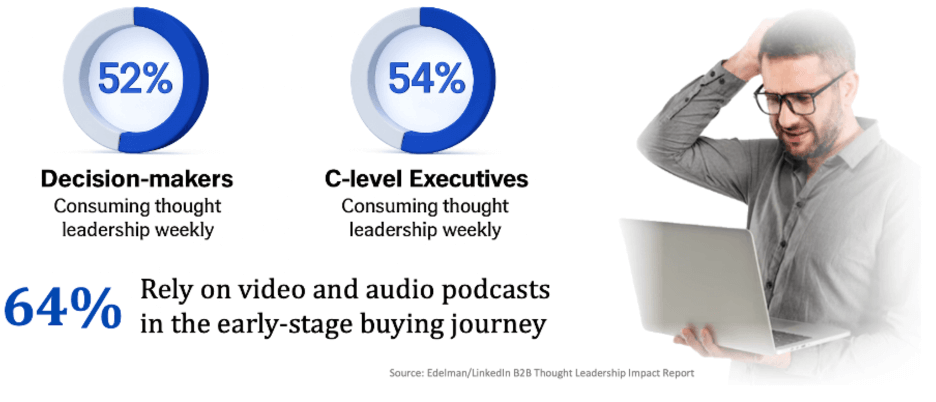
In this environment, conversational formats play a central role in discovery—helping brands and leaders connect in ways that are more relatable, engaging, and accessible than ever before. AI engines especially love interviews, Q&A transcripts, and FAQs because they are conversational entities, just like humans.
When executives are visible, telling their unique story, purpose, credibility, and differentiation, they are not only more likely to attract the ideal customer, but to feed AI engines what they want.
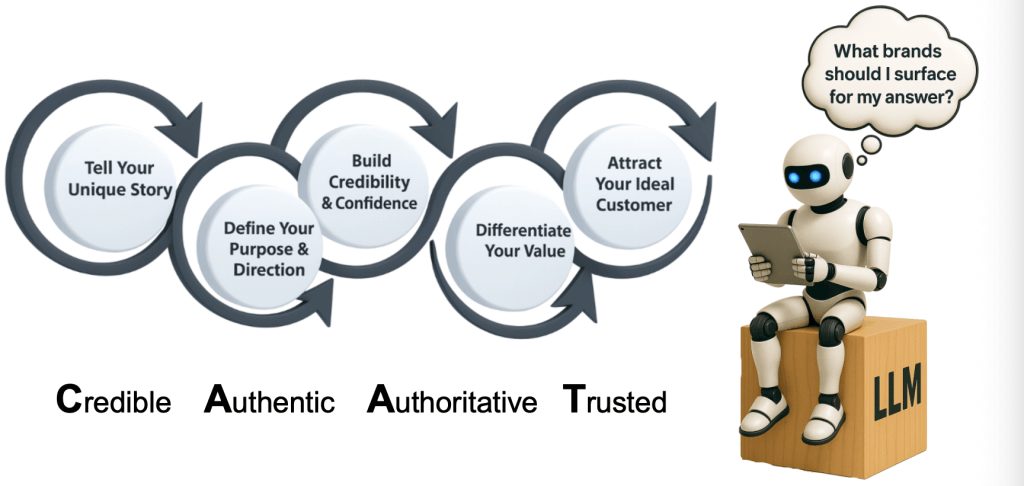
And, critically, AI engines love people and conversations because they are built to interact with people through conversations! And, conversely, that is why the survey showed 69% are increasing spending in video and audio media formats as a key AI-ready channel.
This creates a new strategic mandate: Brands must not only tell their story, but also embody it with recognized experts, validated insights, and credible third-party amplification.
How LLMs Choose Brands
To understand how brands appear in AI-powered search results, theCUBE Research has developed a four-layer AEO framework that reflects how LLMs build, retrieve, rank, and validate information, each of which can be “tuned” to your brand’s advantage.
- The Semantic Layer: Six tunable “levers” that determine whether AI engines can reliably understand your brand, its entities, context, products, people, and topical associations. If a model cannot semantically distinguish your brand, visibility collapses immediately.
- The Relevance Layer: Five tunable “levers” that evaluate how well your content aligns to buyer-intent questions. This layer separates brands that “exist” in the model from those that “matter” in a specific decision context.
- The Citability Layer: Four tunable “levers” that govern whether an AI engine considers your content credible enough to reference in the moment of the question. Brands that lack a consistent flow of relevant signals rarely make the cut.
- The Validation Layer: Four key principles that build a sense of brand integrity. When a brand demonstrates credibility, authenticity, authority, and trust, AI systems recognize it as a stable, reliable brand.
Across these four layers sit 19 tunable attributes that GTM leaders can influence through structured content, distribution strategy, executive visibility, and multi-channel credibility-building. These attributes map directly to how AI engines learn, retrieve, and rank content, making them the closest thing we have today to AEO “control knobs.”
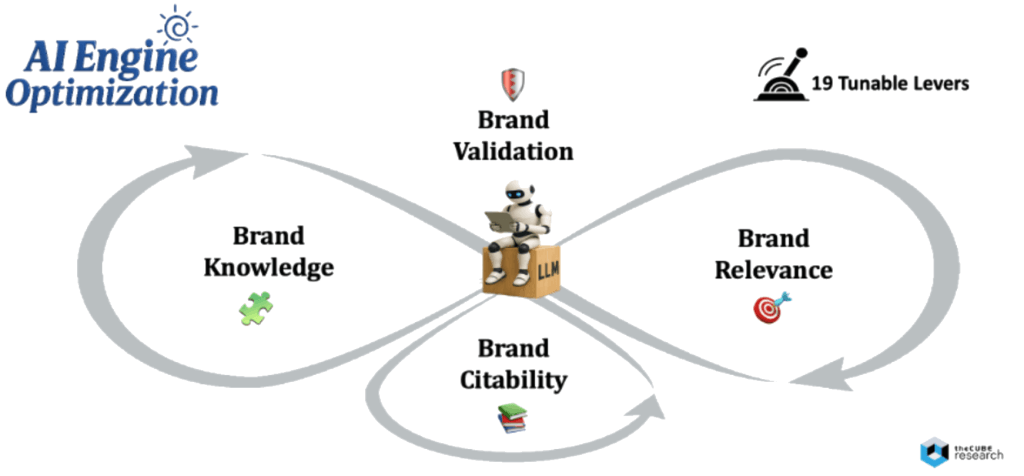
A detailed breakdown of the four layers and all 19 attributes is available in the AI Engine Optimization Guide mentioned previously.
From Insight to Action
Understanding how LLMs recognize, rank, and recommend brands is only the first step. The real advantage comes when GTM leaders turn that understanding into a measurable, repeatable system for boosting visibility across the AI engines their buyers trust. That’s where the 19 tunable AEO levers and the ability to benchmark performance across top assistants like ChatGPT, Claude, Grok, and Gemini become practical and actionable.
Turning insight into action begins with a structured AEO SWOT analysis. For each of the 19 attributes across the four layers, teams assess internal strengths and weaknesses, while scoring external opportunities and threats based on how different AI models currently interpret their brand. Because every assistant learns and ranks content differently, these cross-model comparisons reveal where a brand is strongly understood, where signals fail to land, and where competitors may already be gaining ground. What emerges is a multi-dimensional visibility profile that mirrors how AI systems actually process information.
The next step is converting these insights into a unified AEO performance dashboard—a single view that quantifies semantic authority, relevance alignment, citability strength, and CAAT compliance. By tracking evidence density, recency weightings, and model-by-model signal strength, the dashboard gives GTM teams a real-time indicator of whether their brand is becoming more discoverable or drifting into irrelevance. It also exposes the gaps that matter most: missing entity associations, weak topical authority, outdated content, or a lack of third-party validation.
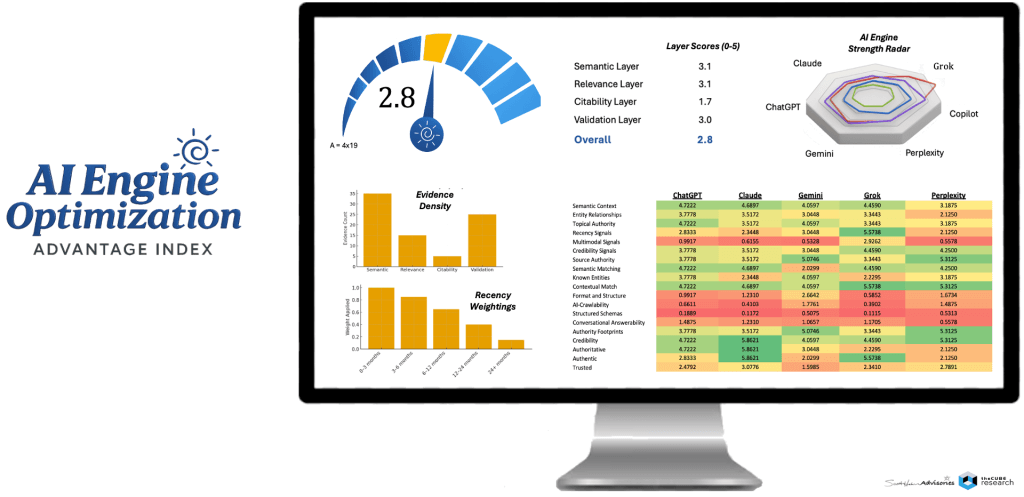
This structured approach closes the loop between strategy and execution. Instead of guessing what improves visibility in AI-powered search, leaders can now measure, prioritize, and tune the precise levers that drive inclusion in AI-generated answers. The result is a living system of brand optimization, one that evolves as AI models evolve, and gives organizations a defensible advantage in the emerging era of AI-mediated discovery.
If LLMs are the new gatekeepers of visibility, and thus buyers, then the AEO dashboard is the new instrument panel for navigating that reality.
Act Now
The Kickstand + Pavilion study offers both a warning and an opening. AI-powered search engines are no longer a peripheral influence on discovery—they are becoming the primary arbiters of who gets visibility and who gets recommended. The GTM leaders who understand how AI systems learn, reason, and validate brands will define the next decade of competitive advantage.
This widening gap between urgency and readiness is exactly where market leaders will be created. Traditional SEO signals are fading, and visibility has shifted from clicks to credibility, an intelligence-layer decision made inside the answer itself. To be found, trusted, and recommended, vendors must feed AI engines the structured, evidence-backed signals they rely on: authority, authenticity, recency, semantic clarity, and third-party validation.
The brands that operationalize AEO now,before the practices are widely understood, will gain an accelerating, durable advantage in a zero-click world where buyers make decisions long before they ever reach a website. Those who delay may discover too late that invisibility in AI is invisibility in the market.
In the age of AI discovery, you don’t win page one—you win the answer.

📩 Contact Me 📚 More AI Research 🔔 Next Frontiers of AI Digest



